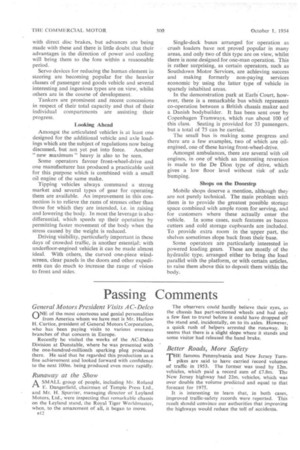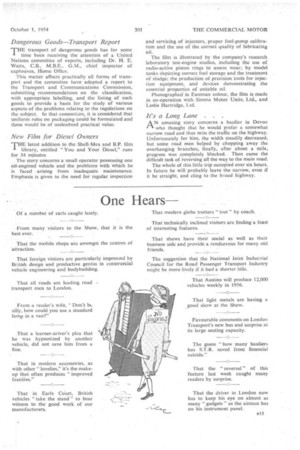Passing Comments
Page 50

Page 51

If you've noticed an error in this article please click here to report it so we can fix it.
General Motors President Visits AC-Delco
ONE of the most courteous and genial personalities from America whom we have met is Mr. Harlow H. Curtice, president of General Motors Corporation, who has been paying visits to various overseas branches of that concern in Europe.
Recently he visited the works of the AC-Delco Division at Dunstable, where he was presented with the one-hundred-millionth sparking plug produced there. He said that he regarded this production as a fine achievement and looked forward with confidence to the next 100m. being produced even more rapidly.
Runaway at the Show
A SMALL group of people, including Mr. Roland r-1 E. Dangerfield, chairman of Temple Press Ltd., and Mr. H. Spurrier, managing director of Leyland Motors, Ltd., were inspecting that remarkable chassis on the Leyland stand, the Royal Tiger Worldmaster, when, to the amazement of all, it began to move. B12
The observers could hardly believe their eyes, as the chassis has part-sectioned wheels and had only a few feet to travel before it could have dropped off the stand and, incidentally, on to its axles. However, a quick rush of helpers arrested the runaway. It seems that there is a slight slope where it stands and some visitor had released the hand brake.
Better Roads, More Safety
THE famous Pennsylvania and New Jersey Turnpikes are said to have carried record volumes of traffic in 1953. The former was used by 12m. vehicles, which paid a record sum of £7.8m. The New Jersey highway had 22m. vehicles, which was over double the volume predicted and equal to that forecast for 1975.
It is interesting to learn that, in both cases, improved traffic-safety records were reported. This result should convince our authorities that improving the highways wou4d reduce the toll of accidents.
Dangerous Goods—Transport Report
THE transport of dangerous goods has for some
time been receiving the attention of a United Nations committee of experts, including Dr. H. E. Watts, C.B., M.B.E., G.M., chief inspector of explosives, Home Office.
This matter affects practically all forms of transport and the committee have adopted a report to the Transport and Communications Commission, submitting recommendations on the classification, with appropriate labelling, and the listing of such goods to provide a basis for the study of various aspects of the problems relating to the regulations on the subject. In that connection, it is considered that uniform rules on packaging could be formulated and these would be of undoubted practical value.
New Film for Diesel Owners
THE latest addition to the Shell-Mex and B.P. film I library, entitled "You and Your Diesel," runs for 34 minutes.
The story concerns a small operator possessing one oil-engined vehicle and the problems with which he is faced arising from inadequate maintenance. Emphasis is given to the need for regular inspection and servicing of injectors, proper fuel-pump calibration and the use of the correct quality of lubricating oil.
The film is illustrated by the company's research laboratory test-engine studies, including the use of radio-active piston rings to assess wear; by model tanks depicting correct fuel storage and the treatment of sludge; the production of precision tools for injection equipment, and devices demonstrating the essential properties of suitable oil.
Photographed in Eastman colour, the film is made in co-operation with Simms Motor Units, Ltd., and Leslie Hartridge, Ltd.
It's a Long Lane . . .
AN amusing story concerns a haulier in Devon who thought that he would prefer a somewhat narrow road and thus miss the traffic on the highway. Unfortunately for him, the width steadily decreased, but some road men helped by chopping away the overhanging branches, finally, after about a mile, progress was completely blocked. Then came the difficult task of reversing all the way to the main road.
The whole of this little trip occupied over six hours. In future he will probably leave the narrow, even if it be straight, and cling to the broad highway.




























































































































































